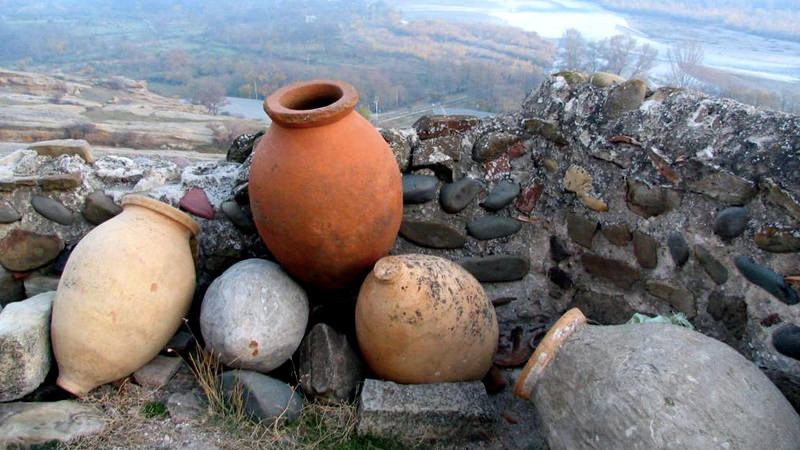Given the proliferation of visually driven food and drink trends (rainbow bagels! unicorn Frappucinos!), one would be forgiven for thinking black wine is a new phenomenon, created for and by the Instagram age. But these inky wines are actually some of the world’s oldest juice, made from an ancient, deeply pigmented red grape.
The Saperavi grape (its name translates to “dye”) is indigenous to the country Georgia, with archeological accounts dating back to 5000 B.C.E. It produces near-black wines that are almost unheard of outside Europe. Older generations of Georgians sometimes refer to Saperavi wines as shavi, or black. One of 525 indigenous grapes in Georgia, Saperavi is among the oldest varietals in existence. It hails from Kakheti, Georgia’s easternmost region on the Russian border.
Saperavi is now Georgia’s most popular wine and is becoming increasingly available internationally. A few wineries in the United States, Eastern Europe, and Australia are growing it and producing their own bottles.
Chuck Zaleski, winemaker at Fero Vineyards and Winery, makes Saperavi in Lewisburg, Pennsylvania. “It always sells out,” he says. (He’s not exaggerating; according to Fero’s website, at press time its Saperavi is unavailable through February 18.)
Saperavi is approachable and relatable, like a Shiraz, says Kate Gersamia, owner of Georgia’s Lukasi Winery. The tastes echo blackberries, dark fruits, beet, spice, vanilla, and toasty flavors, with a smooth texture and ample acidity. It’s an excellent food wine as well; black wines pair well with fatty meats, fried vegetables, walnuts (widely used in Georgian cuisine), and cheeses. Zaleski finds it has a broader range for rich foods than many other red wines, due to its acidity.
This wine has historically been made in buried clay vessels, but some modern-day winemakers like Gersamia produce it in stainless steel tanks and then age it in barrels. Georgians tend to drink the wine as close to bottling time as possible, but contemporary processes allow for elegant Saperavi wines that can be drunk 10 to 20 years after bottling, Gersamia says.

Like many Georgian wines, Saperavi wines are single-variety, or not blended with other grapes. The results are distinctive. “A sommelier who has never tried Saperavi will easily distinguish it from other wines because of its strong varietal aromas, which are unique [to the grape],” Natia Metreveli, CEO of Vaziani Winery, says.
One surprising place to find black Saperavi wines in the United States is New York’s Finger Lakes region. Dr. Konstantin Frank, founder of the Dr. Konstantin Frank Winery, brought the first Saperavi cuttings to America in 1958. (In fact, Zaleski’s vines came from plants that were brought over from Eastern Europe by Frank more than 50 years ago.)
Until 2013, Saperavi was not a recognized variety according to the U.S. government, so Dr. Frank’s winery labeled it under a proprietary name (which it has now changed to the grape name). Frank’s Saperavi (grown on its Keuka Lake site) is very spicy, with a fragrant, almost “Christmas cake” aroma with notes of cinnamon, clove, and dried herbs. If that description isn’t enough to make you want to get your hands on a bottle, well, maybe the prospect of snapping an Instagram-worthy pic might be.
